Hat Creek Range: 47,000 acres. It’s a big chunk of country, and in 2005, we certified all of it as organic. In fact, even today, in 2016, one acre out of every 100 acres of organic land in the United States is part of Alderspring. More exactly, 1.4% of all organic land in America is on Alderspring Ranch. To be honest with you, it was relatively easy to certify. It is wilderness.
It was 2009, and we had about 165 cow-calf pairs up there that summer. They had scattered like dust to the wind over the 70 square miles of broken mountain country. There were trout-stuffed lakes, glaciated peaks, endless rolling hills cloaked with sagebrush, 55 miles of streams and 27,000 acres of thick fir forest to search for them in. We’d been riding horseback for weeks on end, and the slow gather had been hampered by weather; snowstorms rolled across the peaks, dumping snow up high. Now it was November and I felt we were scraping the bottom of the barrel in terms of finding our lost beeves; we were still missing over 15 pairs.
Cows are like ants. We’ll see an ant struggling toward an anthill with a twig of sagebrush, still some 10 feet away. We come back an hour later, and he is still struggling and has covered only 2 feet of distance. But if we come back in a week or two, Mr. Worker Ant and his compadres have constructed an edifice of ant engineering over a foot tall. It was similar with our cows. Angus Alice and her buddies are seen hanging out in a little meadow over a few days. You see them, and greet them as you roll by on horseback, thinking this is where they’ll be for the summer. A month later, they are 35 miles away. Slow moving, they are ever so persistent finding new grass, new water. They don’t call them range cows for nothing.
My neighbor rancher, Terry, saw my predicament, and could relate. He runs up on the next range, Morgan Creek; their country is nearly twice what ours is: 125 square miles. He calls a pilot friend up regularly this time of year, and boards a Cessna 206 for several hours, hoping to spot some Black Angus color amidst the color of quaking aspen turning gold. At least then, he knows where to ride, saving time, horseshoes, and stock trailer fuel. He tried to talk me into it:
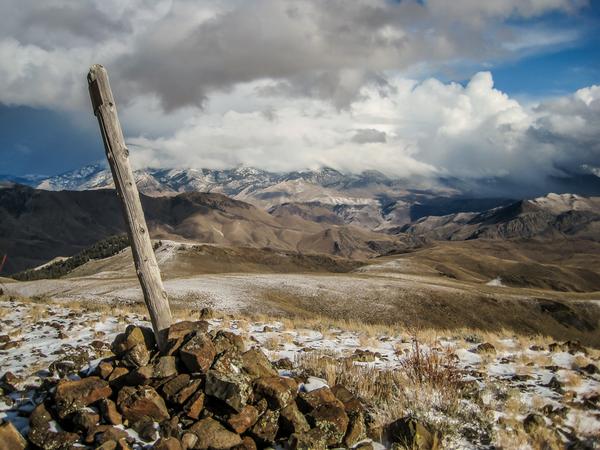
“Why the heck don’t you fly that range? Just call my guy up. He’ll even know where to look. You don’t have to worry about him—he’s been flying these mountains for years with Bob Plummer.”
The country your beeves summer on is mostly roadless and essentially wilderness. Much of it is accessible only by horseback.
“I’ve flown enough in these mountains. We’ll find ’em. Or you guys will”¦they could have slipped through the ridgeline fence and gotten in with your cattle. Besides, look what happened to Plummer.” Bob Plummer, one of the most experienced backcountry pilots in Idaho, had crashed and died up Morgan Creek just 4 years ago scouting for elk.
If I was going to fly with someone, it wasn’t going to be close to the ground trying to spot a cow in the trees. I’d done enough tree level flying in my firefighter days. It was a risky business, I thought, compared to horseback. Besides, we always gathered some of our neighbor’s cattle every year, and they gathered some of ours. We met at the Salmon River with our respective gatherings, and swapped cattle around in corrals next to the river. Those bovines sure could travel.
On this particular day, fresh snow had crusted the Salmon River Mountains, and the morning dawned clear and brisk. Melanie and I set out early after first light from the ranch; we had our two horses, Ginger and Missy, and two border collies; Arrow and Gyp. It would be a long ride across about 35 miles of broken country, and much of it at a brisk trot. We had been skunked so often that I was losing hope in finding our strays. I was really hoping some neighbor would pick them up, and if they did, it would mean my cows had traveled 40 miles.
The fresh snow was my ace in the hole, I thought. It was only 2 inches deep across much of the range, and it meant we would be able to pick up fresh tracks and even date and time it by the shape and size of the tracks. In addition, I would be able to easily see how much big predator activity we had in the night: a wolf pack or even lone mountain lion would leave a clear mark.
Wolves were my biggest concern. They were on a dramatic population upswing in our mountains, feasting on the plentiful elk populations and even domestic cows that summered in the wild country. We had already lost over 15 of our beeves to wolf attacks, and I had no interest in losing more. Melanie and I cut many tracks that day of elk, deer and coyotes, but none of the big predators were on the move in our locale. We found no sign of beeves either. It was getting a little hopeless. We ate in the saddle, knowing that our short light day was going to fade quickly as the afternoon progressed.
And it was getting cold. Our range faced southeast, and as the sun started dropping along the ridge of Table Mountain, the air had a frozen feel about it. The horses were haired up nicely for winter now, and because we wore leather chaps and long dusters (oilskin trenchcoats) most of our heat stayed with us. It was our feet that started to freeze, though. They protruded from long chaps with just a leather cowboy boot around them, and were flapping in the air through stirrups.
Exposed to the elements, they were, and not a dang thing to do about it. An insulated boot simply wouldn’t do. If your horse wrecked on a steep sidehill, you wanted to get yourself separated from horse immediately, or risk getting crushed to death in a rocky rollover. Both Melanie and I had been in tough horse wrecks, and although we appreciated our ride, there was those times a body could really appreciate separation from horse.
The dogs were range tough after running hundreds of miles over the summer. Every now and then they had to stop to chew the ice off their paws, but other than that, they were good. Border pups always have a pretty straight up attitude. You can be frozen, bloody, and tired, but they’ll always bring by a cup of good cheer. I knew they would flat pass out in the back seat on the way home when we finally arrived at the stock trailer.
We said little the whole day, intent on scanning the country for distant cattle and eyes down on the ground, reading the snow for sign. When the wind picked up, I knew that her silence was likely caused by cold. It was a bitter day that played a prelude to the subzero winter that lay ahead. We had crossed three watersheds since morning, and had just dropped into upper Moose Creek. Melanie looked down at the aspen stand below us, a little worried. She remembered that the last time we crossed it, the only way through was a belly deep swamp tightly ringed by impassable surrounding cliffs.
We half waded, half swam our way through the aspen swamp. Most of the leaves had fallen by now, and the wet bottoms were cloaked with the bronzed and fading gold of aspen leaves. Some stubborn, brown and still connected leaves quaked in the breeze overhead, as if to remind us that those trees were not just aspen trees—they were quaking aspen. Our steeds hopped over a log, and arrived high and dry on the other side of the creek bottom, to Melanie’s relief. An elk trail gave us sure footing up the steep timbered hill on the other side of the draw, and ended in a snowy meadow surrounded by a dark fir forest. I had seen enough. We had gone over 20 miles, and had not cut a track. Those cows were gone”¦or worse, dead; likely the feast of a wolf pack starving for grass fed beef.
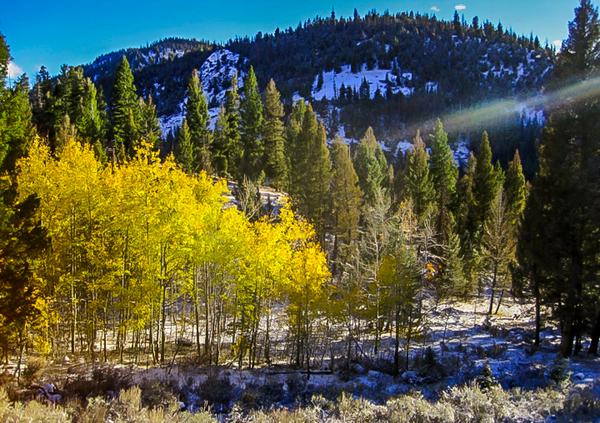
We trotted into the dark timber on the other side of the meadow. I tightened the silk scarf around my neck, and turned up my duster collar to shelter out the frozen breeze that wended its way through the snow-draped fir trees. The sun was officially down now, and we still had 12 to 15 miles to ride out. It would be dark soon, and our steed’s footfalls had gone from a thumping to a crunching as the snow froze with the end of day.
The first clue that something was about to change was Ginger’s ears. They pricked upright, and her head rose as she walked forward haltingly. Her nostrils flared in an attempt to wind whatever was in the air. I instinctively looked to the dogs next. Their heads had risen as well, and in a second, they were off like a like a black and white terror. They streaked for the thick and dark fir forest, and were gone in an instant. Melanie and I both leaned forward on our tired mounts, who remembered to take off at a gallop in the thick trees to follow the dogs.
In a brush popping 5 minutes, we met the dog’s quarry: fifteen head of Alderspring beeves stood bunched together by dutiful Gyp and Arrow. The two collies stood on opposite sides of the bunch, tongues panting, as if to say “We got ’em, boss.”
In spite of the cold, I got a smile out of Melanie. We found them, and we also found the ringleader—the culprit: it was Reet, an English longhorn that I bought from ranch in the middle of Montana 12 years ago.
She had a previous ownership list a mile long on her pedigree, and was thrown in our semi load of Black Angus mama cows by mistake, or so I thought. I wanted nothing more than to reject her, but it was simply too far to send her back. You might think me a bovine racist for rejecting her for her red polka dotted red hide, but I had genetic scruples, or so I thought. English longhorn was not my breed of choice in those early days of my beef understanding.
It turned out that she didn’t owe me anything. She always raised a great calf that was so easy to finish to fat for beef, and we had grown 10 calves by her. But she was a problem cow, and that was why my seller had pawned her off on me.
You see, she was a wild cow, completely comfortable in the mountains with the wolves and cougars. She never looked to come home like the others did, and was probably able to survive subzero winters in those rugged peaks. And that, my dear reader, was the problem. Because along with one such wandering cow there would always be others, easily swayed by Reet’s siren song to explore. And after several years of such wanderlust, well, a rancher might get tired of them.
But for us, it was a good attribute, although hard to reckon with on cold long days like this one. Attributes like the wild genetics found in this animal are one of the things that we now look for in our Angus beeves. Some bovine genetic lines have lost all those wild instincts to range and forage on their own. Such “couch potato” cows get sheltered in barns or southern climes due to their thin hides, and have to get fed high corn rations to maintain weight while raising a calf. They would never think to protect their baby when wolves or even coyotes come looking. Such cows would die up here in our country for lack of a babysitter.
But raising wild protein is what we do. In the summer, it is beef that grazes on wild mountain landscapes that are pristine—they’ve never seen a plow or spray boom. In the winter, the beeves are on our headquarters valley ranch grazing certified organic pastures that support a diversity founded on biologically rich soils with full nutrient density that results from the absence of agrochemicals of any kind.
But in order to harvest those plants, we need beeves that are adept at making the right forage choices, rather than those who have been trained to wait for the farmer to bring feed to the feed bunk, or are bred to grow well on a monoculture of feedstuffs that they have no choice over.
Unfortunately, I have just described much of what is served up as “grass fed” beef in America today, especially the grass fed beef produced by large beef companies. Now that grass fed is trendy and big (and consumers are willing to pay significantly more for it), large companies are simply changing the feedlot model to exclude the grain; feedstuffs like beet pulp, crop residue and potato waste replace the grain in the feed bunk and technically it’s “grass fed.” It’s frustrating to us, who were one of the original “true believers” in the grass fed movement over 20 years ago. Consumers in the grocery store buying big label grass fed beef think they are getting the health benefits of “grass fed” cattle that have actually grazed grass, but nothing could be further from the truth.
Although we are “grass fed,” what we do is really beyond grass fed. And although we are certified organic, what we do here in the mountains of Idaho is truly beyond organic. Alderspring is wild beef. And cows like Reet embody it.
Enjoy the wild ranges with us by plate and your passion for a vision of wild protein.
Thanks for joining us on this journey,
Glenn, Caryl and Girls at Alderspring.



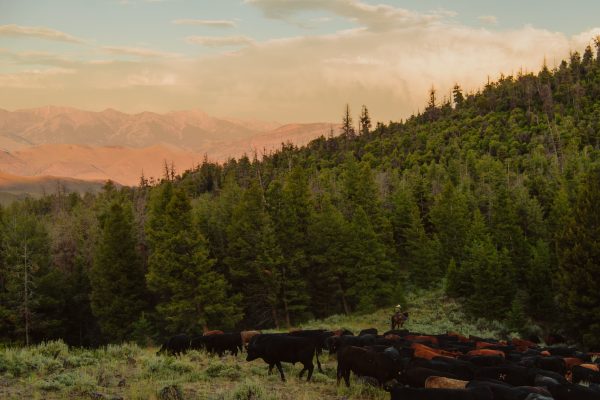
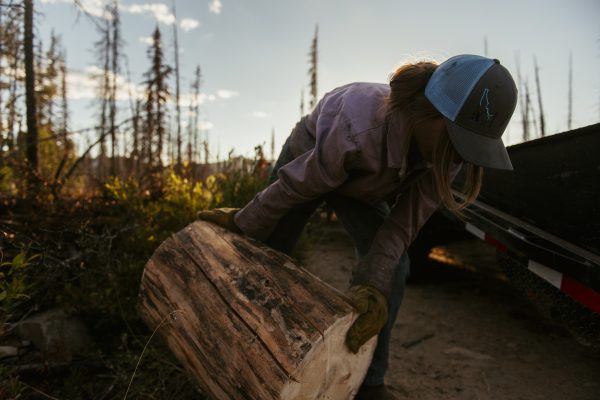
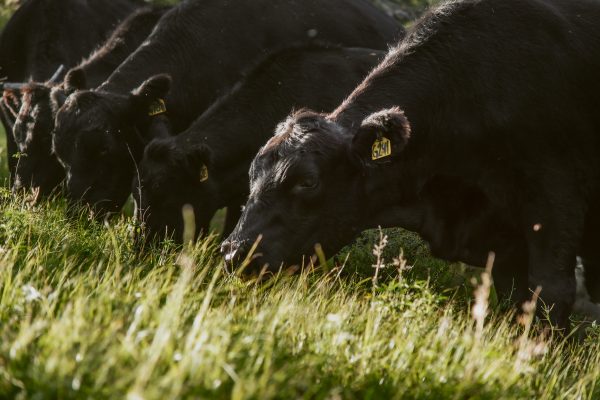

Shirley
I was waiting for the rest of the story…how you got home that night with your beeves🤔